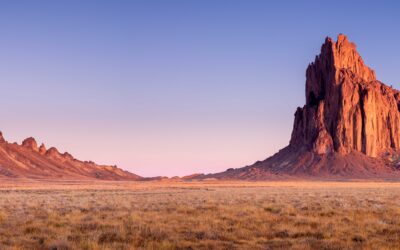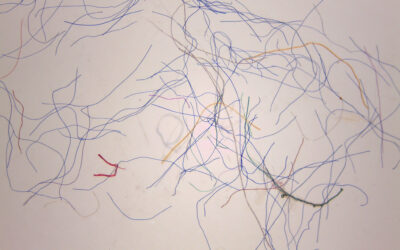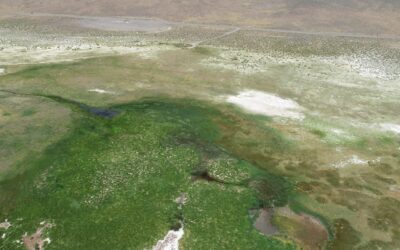Sample gives important details into past dynamics of the Antarctic ice sheet and its cold, dark ecosystems
DRI’s Mark Hausner, Ph.D., is a coauthor on a new study detailing the first layered lake-sediment sample taken from a subglacial lake in Antarctica. Hausner stepped in to assist the project team — dubbed SALSA for Subglacial Antarctic Lakes Scientific Access — after a difficult deployment created challenges in recovering temperature data from their equipment.
“I worked with the team after their return to recover the best temperature data we could,” Hausner says. Although precise temperature observations couldn’t be recovered, Hausner’s expertise with fiber-optic distributed temperature sensing cables enabled him to identify changes in the data that were consistent with other observations.
“Using multiple observation methods really increases your confidence in what you’re seeing,” he says. “In this case, satellite observations, surface geophysics, and the temperature profile through the ice and into the lake all tell the same story of a lake underneath 1 km of ice that’s switching from draining to filling.”
Below is the full press release from the Colorado School of Mines.
Since the discovery 50 years ago of subglacial lakes in Antarctica — some of the least accessible geological features on Earth — scientists have attempted to extract lake bed sediment to learn about the formation, movement, and past conditions of the ice sheet. Now, a team of researchers with the NSF-funded project Subglacial Antarctic Lakes Scientific Access (SALSA) has successfully done so, recovering the first layered sediments from beneath the modern Antarctic ice sheet.
Their findings from analysis of the sediment sample, published March 9 in Geology, give important insight into the larger dynamics of the Antarctic ice sheet and its history, including when the ice sheet was smaller than its current size. Their work adds to the sedimentary record of knowledge of Antarctica and also holds implications for understanding how Antarctica may contribute to global sea level change.
Previous studies of modern subglacial lakes were limited to the timescale of the modern ice sheet due to the challenge of sampling an environment locked beneath thousands of feet of ice. The sediment sample extracted by the SALSA team will allow researchers to better understand subglacial activity across almost two centuries, instead of merely two decades.
“There are places on Earth that we still haven’t explored,” said Matthew Siegfried, assistant professor of geophysics at Colorado School of Mines and a lead author of the paper. “We have now one sample trying to understand an environment that is one and a half times the size of the continental United States. It’s like pulling up a rock in New Orleans and understanding how the Mississippi River and its entire basin has acted for the past 1,000 years.”
The saga of the SALSA team’s quest to explore subglacial lakes is chronicled in “The Lake at the Bottom of the World,” a feature-length documentary film released across multiple streaming platforms on February 28 by the team in partnership with Metamorph Films. The NSF-funded film gives viewers a close look at how the scientists conducted their work amid harsh Antarctic conditions.
‘Like grabbing a package of soup’
Researchers captured the sediment sample on a field expedition in December 2018. They cleanly bored a hole through over 3500 feet of ice over Mercer Subglacial Lake by filling a modified fire hose with sterilized water at nearly 200 °F and aiming it into the ice. They carefully collected sediment cores through a borehole that was constantly freezing back in using a device modified from its typical use in “normal” lakes to fit in a narrow ice borehole.
While researchers knew that even the mere extraction of the sediment from the lake would be a success, the fact that a sample arrived at the lab intact proved even more gratifying.
“We didn’t expect to find this mushy, fragile sediment under the ice sheet,” Siegfried said. “It was basically like grabbing a package of soup, bringing it up 1100 meters to the surface of the ice, shipping it to America, getting it into a CT scanner in Oregon, and somehow maintaining tiny laminations in the sample.”
Previous sediment samples from beneath the modern West Antarctic Ice Sheet have only consisted of a jumbled mixture of marine muds and rocks left behind when glaciers move over the Earth and do not contain a layered history of the region or ice sheet.
“In a 2001 paper published after a decade of subglacial drilling efforts in Antarctica, glaciologist Barclay Kamb somewhat unenthusiastically summarizes that everywhere the project sampled sediments, they found the same uninteresting, sticky, gray mixture,” said Ryan Venturelli, assistant professor of geology and geological engineering at Colorado School of Mines and a lead author on the paper.
“We found that, too. But above that same sticky, gray stuff, we found something different for the first time.”
Understanding subglacial movement
CT imagery of the sample showed a pattern of contrasts that indicated the subglacial lake was filling and draining with water before the scientists’ observational record. This finding offers insight into how long water has been moving under this part of Antarctica — movement that has implications for how the ice sheet moves and contributes to sea level rise. The life cycle of subglacial lakes derived from these contrasts also will enable researchers to better identify how carbon, nutrients and dissolved gasses are transported through the subglacial system to the global ocean.
“We use sediments from normal (subaerial) lakes all the time to build records of regional changes in climate. Subglacial lakes are different, because they are sealed by an overlying ice sheet that shields them from changing seasons and changing climate. Any variation in the subglacial sediment record is driven by changes to the overlying ice sheet and associated water system,” Venturelli said.
“Thanks to satellites that have helped us spy on Antarctica from space since 2003, we have a deep understanding of subglacial lake activity in the modern record, but the sediments we collected as part of SALSA give us an idea of how persistent these features are on a much longer timescale — hundreds of years. It’s our first insight into the life cycle of an active subglacial lake, and that is really exciting,” Venturelli added.
Significance of the sampling effort
The findings shared in Geology come amid more groundbreaking publications from the SALSA team based on the sediment samples they retrieved from Mercer Subglacial Lake. In February, researchers published work in ISME Communications that examined and compared microbial communities in the sediment to other regions under the ice; their work indicated an extensive subglacial ecosystem that is biogeochemically and evolutionarily linked through ice sheet behavior and the transport of microbes, water and sediments. Forthcoming research out soon in AGU Advances, also led by Venturelli, constrains the Antarctic subglacial carbon cycle for the first time and indicates how details of the cycle can be used to estimate how much smaller the West Antarctic Ice Sheet was in the last few thousand years.
“Knowing the dynamics of the ice sheet in the past is critical for predicting how it may respond to changes in the future, but this information has also helped to better understand the connectedness of these ecosystems to processes on the surface and regions beneath deep Antarctic ice that have yet to be explored,” said Brent Christner, a microbiologist at the University of Florida and SALSA Project team member.


